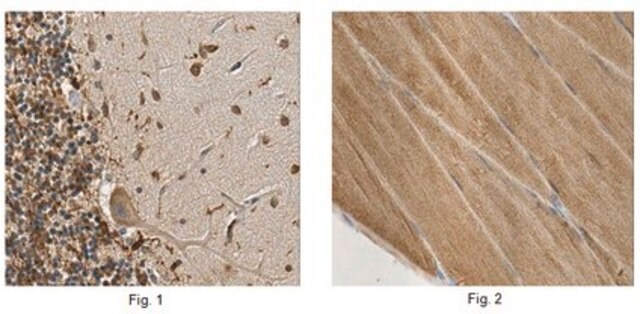B9428
Monoclonal Anti-Bin1 antibody produced in mouse
clone 99D, ascites fluid
Synonym(s):
Anti-Amphiphysin II, Anti-SH3P9, Anti-ampl
About This Item
Recommended Products
biological source
mouse
conjugate
unconjugated
antibody form
ascites fluid
antibody product type
primary antibodies
clone
99D, monoclonal
mol wt
antigen 65-75 kDa
contains
15 mM sodium azide
species reactivity
rabbit, mouse, rat, avian, human
technique(s)
flow cytometry: suitable
immunocytochemistry: suitable using nucleoplasm, subnuclear punctate compartment, and cytoplasm
immunohistochemistry (frozen sections): suitable
immunoprecipitation (IP): suitable
indirect ELISA: suitable
western blot: 1:50,000 using a rat brain cytosol preparation
isotype
IgG2b
Related Categories
General description
Specificity
Immunogen
Application
- western blotting
- enzyme linked immunosorbent assay (ELISA)
- immunoprecipitation
- immunocytochemistry
- immunohistochemistry
- flow cytometry
Biochem/physiol Actions
Disclaimer
Not finding the right product?
Try our Product Selector Tool.
recommended
Storage Class
10 - Combustible liquids
wgk_germany
WGK 3
flash_point_f
Not applicable
flash_point_c
Not applicable
Choose from one of the most recent versions:
Certificates of Analysis (COA)
Don't see the Right Version?
If you require a particular version, you can look up a specific certificate by the Lot or Batch number.
Already Own This Product?
Find documentation for the products that you have recently purchased in the Document Library.
Our team of scientists has experience in all areas of research including Life Science, Material Science, Chemical Synthesis, Chromatography, Analytical and many others.
Contact Technical Service



![[Leu15]-Gastrin I human ≥95% (HPLC)](/deepweb/assets/sigmaaldrich/product/structures/153/342/d4cb3dd7-13f1-46cf-8d1f-3907a5de7a83/640/d4cb3dd7-13f1-46cf-8d1f-3907a5de7a83.png)




